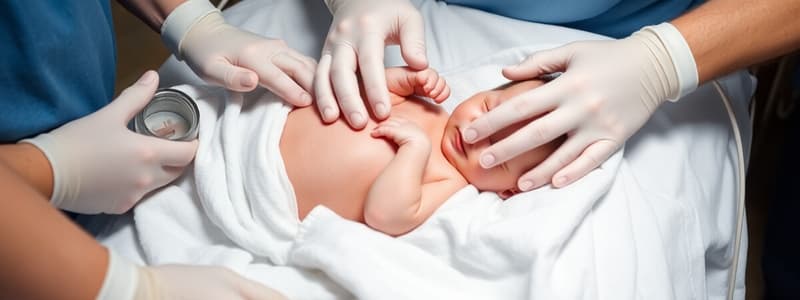Podcast
Questions and Answers
What is the primary physiological change that occurs at birth for a baby?
What is the primary physiological change that occurs at birth for a baby?
- Opening of pulmonary circulation (correct)
- Rapid decrease in body temperature
- Expansion of alveoli with meconium
- Increased heart rate
What is the expected condition of most babies at birth?
What is the expected condition of most babies at birth?
- Born in good condition (correct)
- Require immediate resuscitation
- Always small in size
- Full-term only
What structure becomes redundant after a few minutes post-birth?
What structure becomes redundant after a few minutes post-birth?
- Umbilical cord (correct)
- Aorta
- Placenta
- Pulmonary veins
What causes respiratory distress in newborns as opposed to adults?
What causes respiratory distress in newborns as opposed to adults?
Which of the following is NOT a characteristic of babies at birth?
Which of the following is NOT a characteristic of babies at birth?
What physiological factor may stimulate the first breath in a newborn?
What physiological factor may stimulate the first breath in a newborn?
Why is thermoregulation essential for newborns?
Why is thermoregulation essential for newborns?
What risk increase is associated with each degree below 36.5 degrees Celsius for an infant?
What risk increase is associated with each degree below 36.5 degrees Celsius for an infant?
Which of the following actions should be prioritized immediately after birth to optimize thermoregulation?
Which of the following actions should be prioritized immediately after birth to optimize thermoregulation?
During the initial assessment of a newborn, which color indicates good perfusion?
During the initial assessment of a newborn, which color indicates good perfusion?
What is considered a good tone in a newborn during the first assessment?
What is considered a good tone in a newborn during the first assessment?
What is the normal respiratory rate for a healthy newborn in the first minute of life?
What is the normal respiratory rate for a healthy newborn in the first minute of life?
Which environmental consideration is recommended to optimize thermoregulation for a newborn?
Which environmental consideration is recommended to optimize thermoregulation for a newborn?
What is the primary type of arrest that most babies experience at birth?
What is the primary type of arrest that most babies experience at birth?
Which of the following changes in circulation must occur at birth?
Which of the following changes in circulation must occur at birth?
What primarily stimulates a newborn to take its first breath?
What primarily stimulates a newborn to take its first breath?
Which statement best describes the state of a newborn immediately after birth?
Which statement best describes the state of a newborn immediately after birth?
During the transition at birth, which of the following is NOT a typical physiological change?
During the transition at birth, which of the following is NOT a typical physiological change?
Which method is NOT recommended for maintaining thermoregulation in newborns?
Which method is NOT recommended for maintaining thermoregulation in newborns?
What is considered a sign of poor condition indicated by the tone of a newborn during the initial assessment?
What is considered a sign of poor condition indicated by the tone of a newborn during the initial assessment?
After birth, what is an appropriate action to take if the baby is wet?
After birth, what is an appropriate action to take if the baby is wet?
What risk is associated with a newborn having a temperature of 35.5 degrees Celsius?
What risk is associated with a newborn having a temperature of 35.5 degrees Celsius?
Which of the following is a characteristic of spontaneous aeration of the lungs at 0.3 seconds after birth?
Which of the following is a characteristic of spontaneous aeration of the lungs at 0.3 seconds after birth?
Which condition indicates that a newborn may need immediate assistance during the initial assessment?
Which condition indicates that a newborn may need immediate assistance during the initial assessment?
What breathing rate is considered normal for a healthy newborn in the first minute of life?
What breathing rate is considered normal for a healthy newborn in the first minute of life?
Which of the following statements about hypoxia is true regarding its role in stimulating the first breath of a newborn?
Which of the following statements about hypoxia is true regarding its role in stimulating the first breath of a newborn?
Flashcards are hidden until you start studying
Study Notes
Newborn Life Support Overview
- Most newborns are born healthy and adapt well to birth circumstances.
- Resuscitation or transitional support needs may be unpredictable at birth.
- The Newborn Life Support Algorithm is applicable from birth up to 12 hours old.
Fetal Circulation Transition
- Upon birth, key physiological changes occur:
- Fetal circulation must close rapidly.
- The umbilical cord becomes non-functional after a few minutes.
- Pulmonary circulation must initiate and open, typically occurring spontaneously.
Differences in Cardiac Arrest Causes
- In adults, cardiac arrests are the primary cause of collapse.
- In infants, respiratory arrest is most common.
Characteristics of Newborns at Birth
- Newborns are typically small, wet, and connected to the placenta.
- Their lungs contain fluid before the first breath.
Stimulation for First Breath
- Factors that can stimulate the first breath include:
- Physiological hypoxia.
- Changes in temperature.
- Physical stimulation.
Importance of Thermoregulation
- Newborns are highly susceptible to rapid heat loss, necessitating careful thermoregulation practices.
- Lower temperatures significantly increase mortality risk: a decrease of 1°C below 36.5°C correlates with a 28% rise in infant mortality.
Strategies for Optimizing Thermoregulation
- Ensure a suitable environment by eliminating drafts, closing windows, and increasing room temperature.
- At birth, effectively dry the baby, replacing wet cloths with dry ones, and provide a hat to retain body heat.
- Wrap the baby in dry towels and consider using a blizzard blanket or a transwarmer if available.
Initial Assessment During the First Minute of Life
- Colour Assessment:
- Pink coloration indicates good perfusion.
- Blue/purple suggests a transitioning status.
- Pale skin indicates poor transition requiring immediate help.
- Tone Assessment:
- Flexed and spontaneous movement suggests good condition.
- Floppiness indicates poor condition, necessitating prompt intervention.
- Breathing Assessment:
- Normal respiratory rate is between 40-60 breaths per minute.
- A heart rate around 100 bpm is stable; continue monitoring thereafter.
Newborn Life Support Overview
- Most newborns are born healthy and adapt well to birth circumstances.
- Resuscitation or transitional support needs may be unpredictable at birth.
- The Newborn Life Support Algorithm is applicable from birth up to 12 hours old.
Fetal Circulation Transition
- Upon birth, key physiological changes occur:
- Fetal circulation must close rapidly.
- The umbilical cord becomes non-functional after a few minutes.
- Pulmonary circulation must initiate and open, typically occurring spontaneously.
Differences in Cardiac Arrest Causes
- In adults, cardiac arrests are the primary cause of collapse.
- In infants, respiratory arrest is most common.
Characteristics of Newborns at Birth
- Newborns are typically small, wet, and connected to the placenta.
- Their lungs contain fluid before the first breath.
Stimulation for First Breath
- Factors that can stimulate the first breath include:
- Physiological hypoxia.
- Changes in temperature.
- Physical stimulation.
Importance of Thermoregulation
- Newborns are highly susceptible to rapid heat loss, necessitating careful thermoregulation practices.
- Lower temperatures significantly increase mortality risk: a decrease of 1°C below 36.5°C correlates with a 28% rise in infant mortality.
Strategies for Optimizing Thermoregulation
- Ensure a suitable environment by eliminating drafts, closing windows, and increasing room temperature.
- At birth, effectively dry the baby, replacing wet cloths with dry ones, and provide a hat to retain body heat.
- Wrap the baby in dry towels and consider using a blizzard blanket or a transwarmer if available.
Initial Assessment During the First Minute of Life
- Colour Assessment:
- Pink coloration indicates good perfusion.
- Blue/purple suggests a transitioning status.
- Pale skin indicates poor transition requiring immediate help.
- Tone Assessment:
- Flexed and spontaneous movement suggests good condition.
- Floppiness indicates poor condition, necessitating prompt intervention.
- Breathing Assessment:
- Normal respiratory rate is between 40-60 breaths per minute.
- A heart rate around 100 bpm is stable; continue monitoring thereafter.
Studying That Suits You
Use AI to generate personalized quizzes and flashcards to suit your learning preferences.




